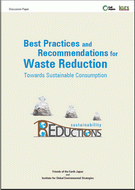March 3, 2014

In February 2014, Friends of the Earth Japan (FoE Japan) and the Institute for Global Environmental Strategies (IGES) co-published a report and recommendations on waste prevention for Asian countries, entitled "Best Practices and Recommendations for Waste Reduction towards Sustainable Consumption," and distributed it at the Fifth Regional 3Rs Forum in Asia, held in Surabaya, Indonesia from February 25 to 27.
This report was jointly developed by the two organizations, with updated case studies, as an English-language version of the Japanese report "Yori sukunai shigen de yori yutakana kurashi wo" (A Richer Life with Fewer Resources), published by FoE Japan in March 2013.
This report provides an introduction to the various activities for waste
prevention systems in Japan, the Republic of Korea, the European countries
and other countries, as well as national level policies (regulations,
economic tools, etc.), independent actions by the industrial sector, and
activities of local communities and NGOs. It introduces (1) examples of
actions to control excessive packaging, (2) policies and actions to reduce
the use of single-use shopping bags, (3) actions to reduce single-use
products, (4) movement to reduce the use of PET bottles and review
policies on tap water, and (5) examples of community building focused on
waste prevention that contribute to local revitalization.s.
The report was produced for policymakers, experts, NGOs, and local organizations involved in 3Rs policies in developing countries in Asia, as a reference guide for actions to reduce waste. Although some examples may not exactly suit the current situation in Asian developing countries, we expect that this paper will be helpful as a compilation of specific measures to reduce and prevent waste.
>Download "Best Practices and Recommendation for Waste Reduction towards Sustainable Consumption" (PDF)
※The report is based on a research project of the Asia Resource Circulation
Policy Research Group, coordinated by Institute for Global Environmental
Strategies and funded by the FY 2014 Asia Resource Circulation Research
Project commissioned by Ministry of the Environment of Japan (MOEJ)

